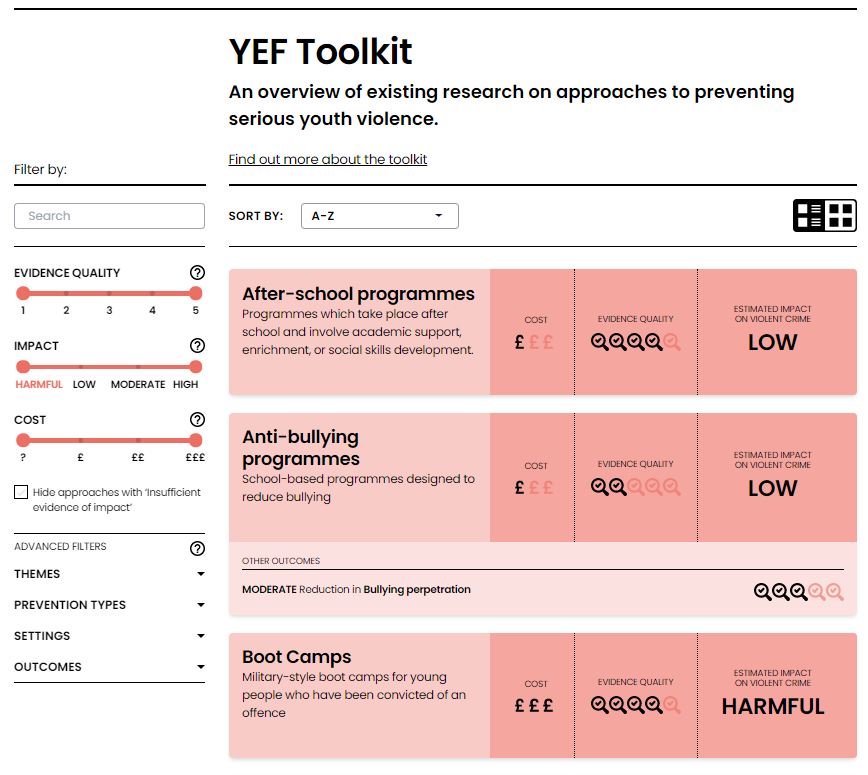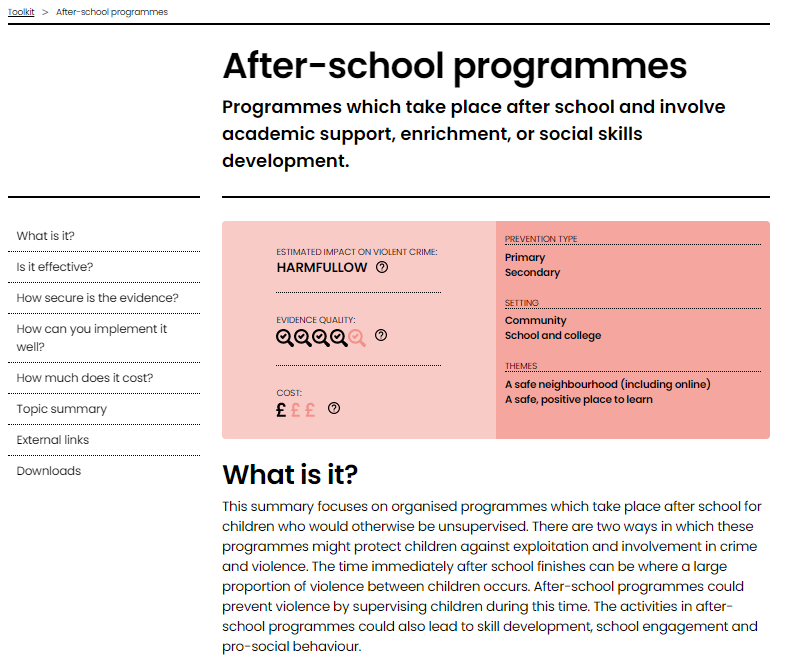Last week, we launched the YEF Toolkit – an accessible, online tool that provides free-to-use summaries of the best available research on what works to prevent children becoming involved in violence.
We’ve developed the Toolkit to help police forces, local authorities, youth charities, school leaders and others use evidence when making decisions about how best to keep children safe from violence.
For example, you could be…
- Planning a new service
- Improving an existing programme
- Commissioning research
- Applying for funding
The Toolkit presents research in a way that’s easy to access, easy to understand and easy to apply. It’s there to complement your own expertise and local knowledge, rather than replace it. So while it can’t provide you with definitive answers, it suggests best bets – approaches that are likely to make a positive difference to the children you work with, because they have worked well in the past.
So when you click onto the YEF Toolkit page, how do you make the most of the information it presents?
At the YEF Toolkit team, we’ve put together some top tips to get you started:
Tip 1: Get stuck into the detail
The front page of the Toolkit is designed to give you an overview. It’s a starting point for understanding the ‘best bets’ – the approaches most likely to be cost effective.

For every topic the Toolkit also provides a much more detailed summary. This extra detail can be really important. It explains whether different ways of implementing the approach lead to different impacts and how you might avoid pitfalls.

Tip 2: Understand what you need in your local area, drawing on the expertise of your colleagues and community
The Toolkit tells you whether an approach has tended to work in the past. But deciding whether it’s likely to work in your area requires expertise and insight into your area, so that you can make a well-informed decision about whether it’s likely to work for you.
For example, focused deterrence has tended to be effective. However, the evidence suggests that it can be a tricky approach to implement – it’s highly complex and requires the collaboration and commitment of many different stakeholders. So specific knowledge of your context and the relevant stakeholders is needed before you can decide whether it would be feasible for you.
Tip 3: Consider the cost and evidence, not just the impact
It can be tempting to just focus on the approaches with the highest impact. However, it’s important to pay attention to other aspects in your decision-making.
The most effective approaches don’t always provide value for money. An approach with a lower average impact could be more cost effective if it’s cheaper to implement.

If you’re considering an approach with a weaker evidence base, you might want to think about evaluating it before rolling out a full delivery.
Tip 4: Plan carefully for implementation
While the evidence might show how effective a particular approach is in principle, if there isn’t enough consideration about how it’ll be put into action it might not have the effect you’re expecting to see.
Quite a lot of the time new approaches are introduced without thinking about how any changes you’re planning might impact on how effective the approach will be, or how best to make sure an approach is successful as possible.
So before you put an approach into practice:
1. Develop a clear plan for how you will implement it.
- Ask yourself what steps need to be taken and by whom.
- Consider the extent to which your organisation is ready to implement the approach, think about whether you need organise training, build staff motivation or create/change team or organisational structures before you start.
- Think about what success would look like for you and how you will monitor this before you make any changes.
2. Make sure you know how to keep track on how your approach is being delivered and adjust it depending on what you find. You can do this by:
- Putting in a plan for ongoing training and support for staff
- Making sure you have mechanisms to monitor processes and feedback from children and young people. This will help you to decide which elements of the approach are working for you and which might need to be adapted or improved.
- Keep refining your programme over time.
Using evidence-based programmes can be particularly helpful when you’re planning to implement a programme, because they often contain a set of implementation steps and requirements that have been tested and refined over time. This means you can be clearer about the extent to which different parts of the programme can be adapted without losing the core elements that are important to achieving your goal to reduce violence.
The Early Intervention Foundation’s Guidebook is a useful start to find well-evaluated programmes.
Related content
-
Blog
Blog:Social Media and Violence Amongst Young People: A Growing Concern
Two questions I get asked a lot as head of the Youth Endowment Fund is “does social media cause violence?” and “what do we do about it?” So, here’s my attempt at some answers. Does social media cause violence? The short answer is we don’t know, but I think it’s likely. Here’s the thing: there… -
Blog
Blog:AI-Powered Insights into Youth Perspectives on Violence
Bringing together stories from 1000s of young people The efforts of Peer Researchers and the Delivery Partner organisations supporting them yielded a remarkable amount rich qualitative data from 4,600 young people on issues of violence. Initially, our priority was to validate GenAI’s capability to precisely analyse the diverse data originating from various locations throughout England… -
Blog
Blog:What have the Youth Endowment Fund been doing over the past five years? Jon Yates explains.
It is five years since the Youth Endowment Fund was born. Five years is a long time – I know because I had a three-year-old when this work started. She’s been replaced by someone who is eight. We exist because she should be growing up in a world where all children feel safe. But that’s…



